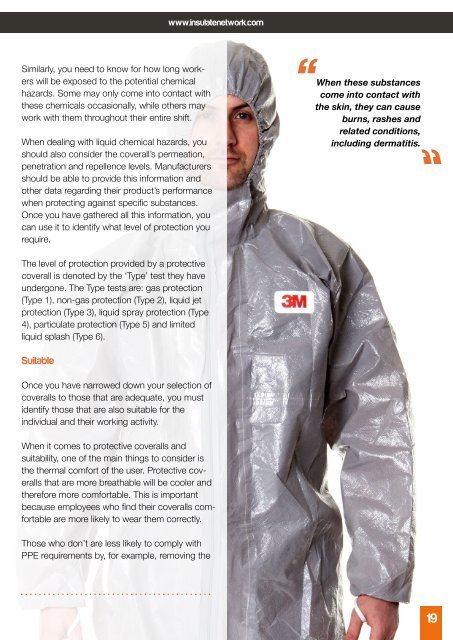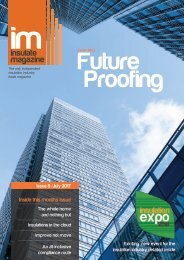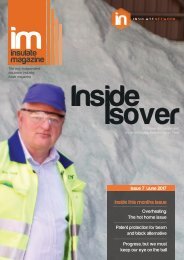Insulate Magazine Issue 11
Create successful ePaper yourself
Turn your PDF publications into a flip-book with our unique Google optimized e-Paper software.
www.insulatenetwork.com<br />
Similarly, you need to know for how long workers<br />
will be exposed to the potential chemical<br />
hazards. Some may only come into contact with<br />
these chemicals occasionally, while others may<br />
work with them throughout their entire shift.<br />
When dealing with liquid chemical hazards, you<br />
should also consider the coverall’s permeation,<br />
penetration and repellence levels. Manufacturers<br />
should be able to provide this information and<br />
other data regarding their product’s performance<br />
when protecting against specific substances.<br />
Once you have gathered all this information, you<br />
can use it to identify what level of protection you<br />
require.<br />
When these substances<br />
come into contact with<br />
the skin, they can cause<br />
burns, rashes and<br />
related conditions,<br />
including dermatitis.<br />
The level of protection provided by a protective<br />
coverall is denoted by the ‘Type’ test they have<br />
undergone. The Type tests are: gas protection<br />
(Type 1), non-gas protection (Type 2), liquid jet<br />
protection (Type 3), liquid spray protection (Type<br />
4), particulate protection (Type 5) and limited<br />
liquid splash (Type 6).<br />
Suitable<br />
Once you have narrowed down your selection of<br />
coveralls to those that are adequate, you must<br />
identify those that are also suitable for the<br />
individual and their working activity.<br />
When it comes to protective coveralls and<br />
suitability, one of the main things to consider is<br />
the thermal comfort of the user. Protective coveralls<br />
that are more breathable will be cooler and<br />
therefore more comfortable. This is important<br />
because employees who find their coveralls comfortable<br />
are more likely to wear them correctly.<br />
Those who don’t are less likely to comply with<br />
PPE requirements by, for example, removing the<br />
19
















